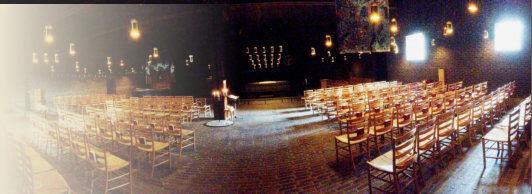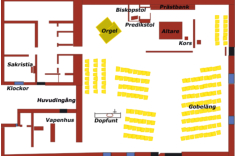

E-post: info@sanktpetrikyrka.se
© Copyright 2007 - www.sanktpetrikyka.se - Anders Clausson


Background/Construction
The church was consecrated on 27th of November, 1966 by Bishop Martin Lindström. The nave is built according to “circumstantes”, the idea of the central place of worship. The area is quadratic, 18 x 18 meter. The height is 6 meter in the east and 5 meter in the west. The nave rests on and is built around a cross of iron (the T-cross or the Antonius-cross). The cross should be essential in the preaching and activity of the church as well as in human life. The ceiling is formed as archs and is a symbol of human spirit life as a waving movement. The building has no arched windows. The floor slopes slowly down to the altar "to help the doubtful towards the communion table" (Lewerentz). The window-glasses are directly mounted on the outside of the wall with brackets, which gives a feeling of missing windows. All electric wiring and water pipes are mounted directly on the walls – nothing should be hidden into the church. The middle aisle corresponds to the holy way (via sacra) of old days which leads to the Holy Communion table. The walls are built up with the dark-brown brick from Helsingborg, which is made by hand craft as well as machine-made. No bricks are adjusted to suit – man is good enough to be used by God even if she is “odd, rough or not adjusted to suit”. The bricks are partly picked by the architect Lewerentz himself from a scrap-yard. Even human beings, who by others are considered as “scrap”, are suitable for the Lord. The daylight and the illumination are sparse. Too much natural light disturbs the full feeling according to the architect. Therefore the lamps must be lightened during service. Architect Lewerentz wanted to create a soft and warm surrounding with quiet and devotion. While sitting for a while in the church the details are coming forward. The chairs are from Denmark and originally designed for the Grundtvig- church (1940) in Copenhagen. Portable chairs in churches are an old tradition and give the opportunity to rearrange the furniture. History Klippans parish church was previously Gråmanstorps church which is situated a few kilometers outside the city. Decades of debate on a new construction of a centrally located church was raised by Bishop Martin Lindström in connection with a pastor installation in 1960. A fund for the collection of funds for the construction of a new church was formed in 1951 by the then vicar Axel Malmberg. In 1962 the site was handed over at the City Park as a gift from Klippan Municipality. That same year approved the Parish Council Sigurd Lewerentz proposed plan for the facility. The proposal was approved by the Royal Majesty Tue October and 30 September 1964 were the first sod of the building committee chairman. Masonry work of the church began in August 1965 by construction firm Helge Lindgren. The architect's eye constantly followed the work on the construction site. A few lines from Bishop Lindstrom's inaugural ”This church makes no effort to resemble churches from times past. It is something completely new...

Already in 1962 the congregation
received Lewerentz official
commissioned to design a "small church"
And in the spring of that year was the
first sketches to a combined church and
parish hall. This also contained
pastersexpedition and a local youth
The site chosen was in one corner of the
city park
Since the building after two years of
intensive preparations started in 1964, it
took another two years before completion
The total cost of the church was 2.8
million, with 1.8 million SEK was the
actual construction cost
References Klippan church foundation
Brochure - St. Peter's Church in 1986.
Ridderstedt, L. Adversus populum - Peter
Celsings and Sigurd Lewerentz sacral
architecture from 1945 to 1975.
Doctoral dissertation. Faculty of
Theology, University of Uppsala, 1998.
ISBN 91-7382-752-5
 Click for larger image
Click for larger image
 Click for larger image
Click for larger image


Sankt Petri Church
A masterpiece of Sigurd Lewerentz
Sankt Petri Church
A masterpiece of Sigurd Lewerentz















